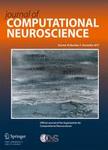版权所有:内蒙古大学图书馆 技术提供:维普资讯• 智图
内蒙古自治区呼和浩特市赛罕区大学西街235号 邮编: 010021

作者机构:RIKEN Brain Sci Inst Amari Res Unit Wako Saitama 3510198 Japan Hokkaido Univ Dept Math Kita Ku Sapporo Hokkaido 0600810 Japan
出 版 物:《JOURNAL OF COMPUTATIONAL NEUROSCIENCE》 (计算神经科学杂志)
年 卷 期:2007年第22卷第3期
页 面:327-345页
核心收录:
学科分类:0710[理学-生物学] 1001[医学-基础医学(可授医学、理学学位)] 07[理学] 071003[理学-生理学]
基 金:Alexander von Humboldt-Stiftung RIKEN
主 题:spike-timing-dependent plasticity synchronization feedforward networks complex networks
摘 要:Spike-timing-dependent plasticity (STDP) with asymmetric learning windows is commonly found in the brain and useful for a variety of spike-based computations such as input filtering and associative memory. A natural consequence of STDP is establishment of causality in the sense that a neuron learns to fire with a lag after specific presynaptic neurons have fired. The effect of STDP on synchrony is elusive because spike synchrony implies unitary spike events of different neurons rather than a causal delayed relationship between neurons. We explore how synchrony can be facilitated by STDP in oscillator networks with a pacemaker. We show that STDP with asymmetric learning windows leads to self-organization of feedforward networks starting from the pacemaker. As a result, STDP drastically facilitates frequency synchrony. Even though differences in spike times are lessened as a result of synaptic plasticity, the finite time lag remains so that perfect spike synchrony is not realized. In contrast to traditional mechanisms of large-scale synchrony based on mutual interaction of coupled neurons, the route to synchrony discovered here is enslavement of downstream neurons by upstream ones. Facilitation of such feedforward synchrony does not occur for STDP with symmetric learning windows.